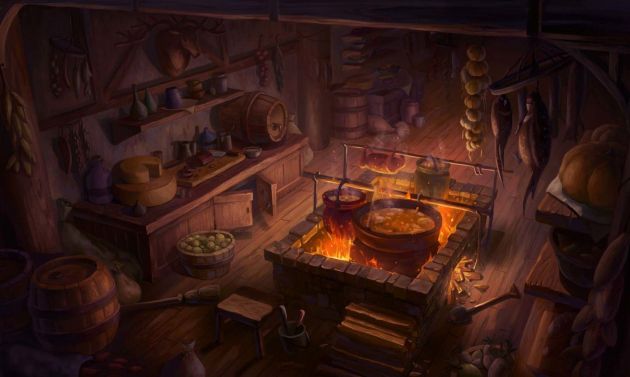Difference between revisions of "Culinary Art (sage ability)"
Tao alexis (talk | contribs) |
Tao alexis (talk | contribs) |
||
| Line 2: | Line 2: | ||
'''Culinary art''' is an [[Knowledge Points|authority]]-status [[Sage Ability|sage ability]] that enables the character to produce [[Food|food]] of a higher quality and taste than an ordinary [[Cooking (sage ability)|cook]], using the same materials. This improves the diner's experience, ensuring a far lower chance of a deleterious effect following the food's consumption. | '''Culinary art''' is an [[Knowledge Points|authority]]-status [[Sage Ability|sage ability]] that enables the character to produce [[Food|food]] of a higher quality and taste than an ordinary [[Cooking (sage ability)|cook]], using the same materials. This improves the diner's experience, ensuring a far lower chance of a deleterious effect following the food's consumption. | ||
| − | == | + | == Ingredients & Preparation == |
The taste of food derives in part from the ingredients used. Peasant food, like [[Durable Foods|durables]] and [[Staple Foods|staples]], is surpassed by epicurean cuisine that's [[Fresh Food|fresh]] and [[Selective Food|selective]]. Best of all, cosmopolitan, [[Premium Food|premium foods]] are sought after expressly for their taste and unusual cultivation. | The taste of food derives in part from the ingredients used. Peasant food, like [[Durable Foods|durables]] and [[Staple Foods|staples]], is surpassed by epicurean cuisine that's [[Fresh Food|fresh]] and [[Selective Food|selective]]. Best of all, cosmopolitan, [[Premium Food|premium foods]] are sought after expressly for their taste and unusual cultivation. | ||
Taste also depends on the ease of preparation. [[Cold Camp Fare|Cold camp fare]], eaten in the outdoors, denies actual cooking of food; if a [[Campfire Fare|campfire]] is possible, the taste improves as well. [[Galley Fare|Galley fare]] enables the benefits of a [[Cookwagon|cookwagon]] or [[Vardo|vardo]]; [[Scullery Fare|Scullery]], the food that can be cooked in an ordinary kitchen. A [[Guestkitchen Fare|guestkitchen]] is even better, as the environment is spacious and well-ventilated ... and finally, the [[Lord's Kitchen|Lord's kitchen]] is best of all. | Taste also depends on the ease of preparation. [[Cold Camp Fare|Cold camp fare]], eaten in the outdoors, denies actual cooking of food; if a [[Campfire Fare|campfire]] is possible, the taste improves as well. [[Galley Fare|Galley fare]] enables the benefits of a [[Cookwagon|cookwagon]] or [[Vardo|vardo]]; [[Scullery Fare|Scullery]], the food that can be cooked in an ordinary kitchen. A [[Guestkitchen Fare|guestkitchen]] is even better, as the environment is spacious and well-ventilated ... and finally, the [[Lord's Kitchen|Lord's kitchen]] is best of all. | ||
| + | == Taste == | ||
A culinary artist is able to work with any food and in any environment — and is decisively able to make more with less. The table shows the various levels of "taste" that the culinary artist can produce. This version is similar to the table found on the [[Nutrition & Preparation of Food|nutrition & preparation of food]] page, but has been upgraded to express the results for a culinary artist. | A culinary artist is able to work with any food and in any environment — and is decisively able to make more with less. The table shows the various levels of "taste" that the culinary artist can produce. This version is similar to the table found on the [[Nutrition & Preparation of Food|nutrition & preparation of food]] page, but has been upgraded to express the results for a culinary artist. | ||
Revision as of 20:04, 16 December 2021
Culinary art is an authority-status sage ability that enables the character to produce food of a higher quality and taste than an ordinary cook, using the same materials. This improves the diner's experience, ensuring a far lower chance of a deleterious effect following the food's consumption.
Ingredients & Preparation
The taste of food derives in part from the ingredients used. Peasant food, like durables and staples, is surpassed by epicurean cuisine that's fresh and selective. Best of all, cosmopolitan, premium foods are sought after expressly for their taste and unusual cultivation.
Taste also depends on the ease of preparation. Cold camp fare, eaten in the outdoors, denies actual cooking of food; if a campfire is possible, the taste improves as well. Galley fare enables the benefits of a cookwagon or vardo; Scullery, the food that can be cooked in an ordinary kitchen. A guestkitchen is even better, as the environment is spacious and well-ventilated ... and finally, the Lord's kitchen is best of all.
Taste
A culinary artist is able to work with any food and in any environment — and is decisively able to make more with less. The table shows the various levels of "taste" that the culinary artist can produce. This version is similar to the table found on the nutrition & preparation of food page, but has been upgraded to express the results for a culinary artist.
____ EDIT LINE ____ The expansion of food-making craft to the level of artistic achievement, so that not only is superior food prepared for consumption, the overall experience of the food itself is heightened. This translates to an improvement of one degree of effect that is shown on the nutrition & preparation of food effects table.
The food experience is described as ten effects: affliction, diarrhea, vomit, misery, tired, grumpy, no effect, sated, happy and elated. Whatever the rolled result may have been, the culinary artist improves this effect by one degree: affliction becomes diarrhea, diarrhea becomes vomit, vomit becomes misery and so on, up through happy becoming elated. Naturally, this provides a comparative improvement in the diner’s well-being.
Because the skill adds to the previously existing cooking ability, this enables a culinary artist to have a 50% chance of producing elation in the diner, even when the food would have been originally mouth-watering in the hands of an unskilled person.
Note, however, that the effect cannot exceed the best possible result at that level of taste. The effect of tasty, for example, could not improve to "sated."
See Also,
Cuisine (sage study)
Gastronomy (sage field)
